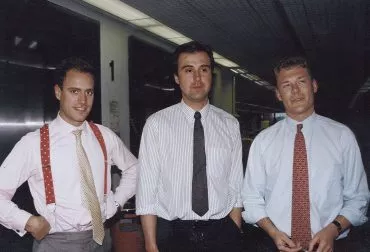About
News UK
Press Gang: Hayes (right) with Jonathan Wilson (centre) and Simon Daglish (left) at The Telegraph in 1989
Writing in Media Week, Paul Hayes reflects on three decades in the fast-changing media business.
"Media Week and I have both been operating in the fast-paced, dynamic media business for 30 years. I was a fresh-faced 23-year-old when Media Week arrived and helped to legitimise the practice of media, as well as creative and marketing, as a rapidly emerging skill, discipline and opportunity.
Thirty years on, I’m sure we are both a lot wiser and have endured a setback or two but still find this business exciting. For the bold and the brave who are prepared to be curious, ambitious and forward-looking, I am adamant there is still no industry as interesting to work in, succeed in, make friends in or even, if like me you marry the boss, start a family in.
So what have been the defining moments for me over those years? When we began, Margaret Thatcher was in power, everyone still believed that Prince Charles and Diana were happily married, and us media executives all wore double-breasted Hugo Boss, drank Beaujolais Nouveau and danced to Duran Duran.
Professionally, for me and thousands of others, the Wapping dispute at the start of 1986 defined the newspaper industry for decades to come. It introduced flexible working and the adoption of new technology. The ensuing explosion of pagination in newspapers brought huge value to the reader with new sections on everything from sport to gardening. With those new sections came new advertising opportunities, meaning that revenues could improve, coverprice could be held and audiences maintained.
An industry that had been held back by the hot-metal and labour-intensive Linotype method started to grow and prosper again by embracing new technology. It is easy to forget, but the launch of The Independent in 1986 could not have happened had it not been for that protracted dispute over Wapping.
New technology reared its head again in 1994. Having joined the Conrad Black-owned Telegraph in 1989, and as part of a team that included Hugo Drayton, Saul Klein and Andy Jonesco, we pitched the idea that this new computing phenomenon called the World Wide Web might have a future.
To his credit, Conrad bought the idea that early technology adopters were young and upmarket and would therefore complement the existing Telegraph audience well. On 15 November 1994, we launched the Electronic Telegraph, the first newspaper on the web.
I was responsible for the electronic newspaper’s advertising sales, with a team that included a young Alex Hole, now at Amazon. I remember more than one agency strategist expressing doubts that this electronic idea would ever be anything more than a niche market. I will not embarrass the agency leaders who told me that such an idea had no future.
There were others, such as Mandy Pooler, then at Ogilvy & Mather, who recognised the potential of an electronic news operation straight away and tried to get clients to embrace the opportunity. It was a hard slog back then, but we had a lot of fun trying to convince people about the benefits of the World Wide Web.
Fast forward to November 2003: England win the Rugby World Cup and The Times is about to overturn two centuries of history, moving away from a broadsheet format and, under Robert Thomson, launch its compact edition. The marketing campaign under Andy Mullins – "It’s not big but it is clever" – catches fire and, after a year of circulation increases, we stop printing the broadsheet version altogether.
This has always been an industry at its finest when confronting a challenge. How long did we give ourselves to change all of our production processes, print two newspapers, not one, two flatplans, ad sales in different formats and create a go-to market proposition? Just 11 working days. Was it exciting? Oh, yes.
So where are we today? Adapting to new challenges, printing across multiple platforms in multiple formats and reaching larger and more engaged audiences than ever before. We are still restless and curious and we still break great stories: from The Guardian’s Edward Snowden coverage to the Telegraph’s MPs exposé, from The Times’ Rotherham sex-abuse scandal to The Sun telling us that the world’s fattest bloke lives in Ipswich.
And how clients and agencies have changed. Smarter, more informed and more demanding, certainly. A multitude of choice with all media having to work harder and more innovatively than ever before to justify taking a client’s money.
This will always be a meritocratic industry where the creative, the risk-takers, the hard-working and the ambitious will thrive… and you get to have a lot of fun too."
This article first appeared in Media Week.


